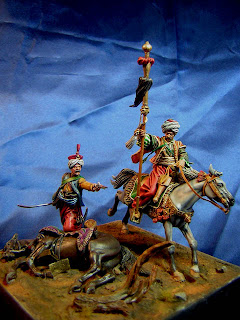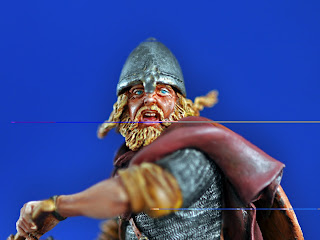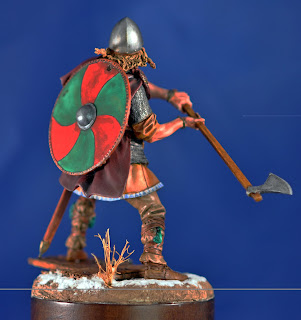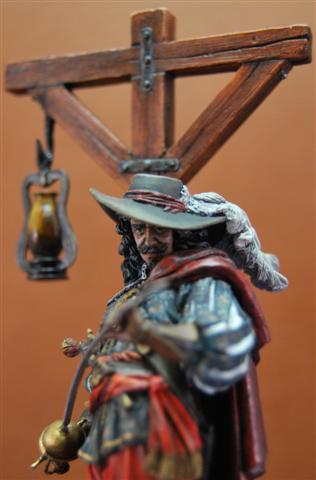This piece is my first 90 mm scale figure. Produced by Soldiers, it is an old figure from my stock. Painted with acrylics and oils.
Algu's World of Miniatures
Welcome!
Dear visitors,
Welcome to my world of miniatures!
Please feel free to visit this blog and do not hesitate to add your comments.
The figures are painted with high quality acrylic and artists oil paints. All figures are mounted on a custom made wooden base with groundwork which completes the scene.
Welcome to my world of miniatures!
Please feel free to visit this blog and do not hesitate to add your comments.
The figures are painted with high quality acrylic and artists oil paints. All figures are mounted on a custom made wooden base with groundwork which completes the scene.
Thanks for your visit,
Dr. Alguhan AKSAR
________________________________________________________________
Dr. Alguhan AKSAR
________________________________________________________________
Francois L'Ollonais (1635-1668)
The famous buccaneer Jean David Nau, known as Francois L'Ollonais was brought to life by Pegaso Models at 75mm scale. Sculpted by Maurizio Bruno.
Francois L'Ollonais, Frenchman, known also as "flail of the Spaniards" was very famous with his naval actions on Caribbean. He was also very famous with his cruelty. He was an expert torturer, and he used his skills on Spaniards. On his last journey, trying to escape from the Spaniards, he was captured by Indians and some rumor goes that he was eaten by them.


Francois L'Ollonais, Frenchman, known also as "flail of the Spaniards" was very famous with his naval actions on Caribbean. He was also very famous with his cruelty. He was an expert torturer, and he used his skills on Spaniards. On his last journey, trying to escape from the Spaniards, he was captured by Indians and some rumor goes that he was eaten by them.


Etiketler:
Francois L'Ollonais (1635-1668)
Peyk - Sultan's Messenger

Peyk means postman or courier in Persian language but in Ottoman military terminology, the term is used for the pedestrian messengers who carries the orders and letters of Ottoman Sultan to long distances bywalking and running. They were always preferable to equestrian messengers because they had advantages to horses. Unlike the horses, they could travel during night and could eat or drink when walking or running. An experienced peyk could walk approximately 16 - 18 hours non-stop with a stabile speed of 7-8 km. per hour.Peyk candidates were chosen at the age of 5-6 and trained in a strict discipline. Besides the special diets and heavy exercises to increase their strenght and endurance to travel long distances, they were also trained to survive and fight with sword and axe.
At the age of 17-18, all candidates were tested in various hard conditions and the successful ones were accepted to Ottoman Palace as Peyk with high salaries.
 Having a Peyk in his service was a privilege in Ottomans. Only the Sultan and his governors commanding the outer states of the Empire could have Peyk.
Having a Peyk in his service was a privilege in Ottomans. Only the Sultan and his governors commanding the outer states of the Empire could have Peyk.Those messengers had original headgear, clothing and weapons. The cloths were richly decorated but comfortable. The most characteristic part of the Peyk’s clothing was the small rings , rattles or metal buttons in the front skirt of his jacket. When Peyk was walking or running, the rattles were ringing as a sign of his arrival.
The people who hear this voice were opening him the road, giving him priority on his trip or supporting him by giving water or food. The rattles had another important function; their periodical ringing were helping him to concentrate and catch a rythm when running or walking. The typical weapon and also a symbol of Peyk was Teber, a double-sided spear-axe with half moon or crescent shaped blades. It was useful both as a weapon and a walking stick in his long trips.
Text by my dear friend Engin Kayral
This model kit comes from Pegaso Models at 75 mm scale. Sculpted by Maurizio Bruno. A fantastic sculpture indeed! Thanks Maurizio!




Kavas Bashi 1780-1820
This fantastic piece was masterfuly sculpted by Maurizio Bruno for Pegaso Models at 75 mm scale.
I am glad that I had the opportunity to paint it. It was fun and a great experience for me.
The Kavas were the guards of the Ottoman vizier and their chief was known as Kavasbashi. Every Kavasbahi had almost 100 kavas under their command. They were used also as armed guards at the foreign representations of the Ottoman Empire. They served also as local police corps. They were arresting the thieves and the ones disturbing the community order, and leading them to the courts.
I am glad that I had the opportunity to paint it. It was fun and a great experience for me.
The Kavas were the guards of the Ottoman vizier and their chief was known as Kavasbashi. Every Kavasbahi had almost 100 kavas under their command. They were used also as armed guards at the foreign representations of the Ottoman Empire. They served also as local police corps. They were arresting the thieves and the ones disturbing the community order, and leading them to the courts.
Etiketler:
Kavas Bashi 1780-1820
Mameluks
I used two different figure kits for this vignette. Both are sculpted by Victor Konnov for Pegaso Models at 54 mm scale.
Painted with oils over acrylics. I painted the Mameluk with grey horse on April 2008 and presented it as a single figure. Then a collectioner came with the second figure kit and wanted both of them on a single base. I am not sure exactly which month, the vignette was created within the year 2009.
It was a nice project to work on. Napoleon formed his own Mameluk corps, the last known Mameluk force, in the early years of the 19th century, and used Mameluks in a number of his campaigns. Even his Imperial Guard had Mameluk soldiers (1798-1805). This vignette shows two of these Mameluk Guards. The one with the dead horse is an officer.









Painted with oils over acrylics. I painted the Mameluk with grey horse on April 2008 and presented it as a single figure. Then a collectioner came with the second figure kit and wanted both of them on a single base. I am not sure exactly which month, the vignette was created within the year 2009.
It was a nice project to work on. Napoleon formed his own Mameluk corps, the last known Mameluk force, in the early years of the 19th century, and used Mameluks in a number of his campaigns. Even his Imperial Guard had Mameluk soldiers (1798-1805). This vignette shows two of these Mameluk Guards. The one with the dead horse is an officer.









Subscribe to:
Posts (Atom)

















